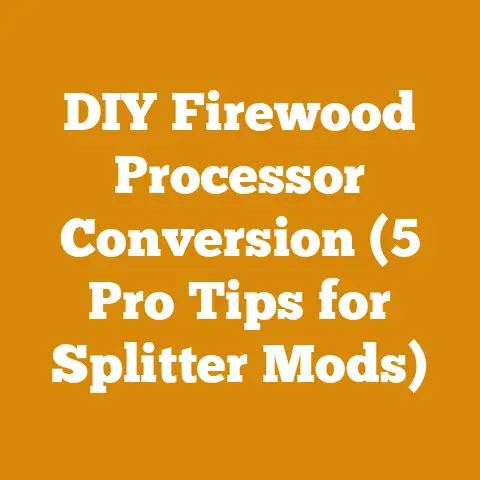Wood Stove in Fireplace Opening (5 Pro Tips for Efficient Heating)
Let’s dive into making your home a cozy haven with a wood stove nestled right in your fireplace opening. But before we get ahead of ourselves envisioning crackling fires and toasty toes, let’s acknowledge that every room is different. The cozy reading nook needs a different approach than the cavernous living room, right?
Think about the size of the space you’re trying to heat. A small, highly efficient stove might be perfect for a smaller area, while a larger, more powerful model is necessary for bigger rooms. Insulation plays a huge role too. A well-insulated home won’t demand as much heat output as an older, draftier one. And don’t forget about the layout! Open floor plans allow heat to circulate more freely, while rooms with closed doors might need supplemental heating.
I’ve seen it all, from folks trying to heat entire farmhouses with tiny stoves to those who overdo it and end up sweating in January. The key is to match the stove to the room’s specific needs. So, before we jump into the “how,” let’s take a moment to think about the “why” – why this stove, for this room?
Now that we’ve thought about your particular needs, let’s get into the nitty-gritty of getting that wood stove installed and running efficiently. Here are my top 5 pro tips for maximizing heat output and keeping your home warm all winter long.
Wood Stove in Fireplace Opening: 5 Pro Tips for Efficient Heating
1. The Right Stove for the Right Space: Sizing and Selection
Choosing the right wood stove is the most crucial step. It’s like picking the right tool for the job – a screwdriver won’t hammer a nail, and a too-small stove won’t heat your living room effectively. I’ve seen homeowners make this mistake more times than I can count, and it always leads to frustration and wasted money.
Sizing Matters:
- BTU (British Thermal Units): This is the key metric. BTU measures the amount of heat a stove can produce per hour. To determine the BTU you need, consider the square footage of the area you want to heat, the insulation level of your home, and the climate you live in. There are online calculators that can help you estimate your BTU needs, but a general rule of thumb is around 5,000 BTU per 200 square feet in a moderately insulated home.
- Stove Size: Don’t just think about BTU. Physical size matters too. You need a stove that fits comfortably within your fireplace opening, with enough clearance around it for safety and proper airflow.
- Firebox Size: A larger firebox means you can load more wood, which translates to longer burn times and less frequent refueling. This is especially important if you plan to use the stove as your primary heat source.
Stove Types:
- Cast Iron vs. Steel: Both have their pros and cons. Cast iron stoves radiate heat more evenly and tend to retain heat longer, but they can be more prone to cracking under extreme temperature changes. Steel stoves heat up more quickly and are less susceptible to cracking, but they may not retain heat as well.
- Catalytic vs. Non-Catalytic: Catalytic stoves use a catalytic combustor to burn off smoke and gases, resulting in cleaner emissions and higher efficiency. Non-catalytic stoves are simpler in design and often less expensive, but they may produce more smoke and require more frequent refueling.
- EPA-Certified: Always choose an EPA-certified stove. These stoves meet strict emission standards and are much more efficient than older, non-certified models. EPA certification ensures you’re getting a stove that burns cleanly and efficiently, saving you money on fuel and reducing your environmental impact.
My Experience:
I remember helping a friend install a wood stove in his old farmhouse. He was convinced he needed the biggest, most powerful stove he could find. After some careful calculations and a lot of convincing, we steered him towards a smaller, more efficient model. He initially grumbled, but after the first winter, he was singing its praises. Not only did it heat the house perfectly, but he also used significantly less firewood. The lesson? Bigger isn’t always better.
Data Points:
- EPA-certified wood stoves can be up to 50% more efficient than older, non-certified models.
- A properly sized wood stove can save you up to 30% on your heating bill compared to an oversized stove.
- Cast iron stoves can retain heat for up to 12 hours after the fire has gone out.
Actionable Takeaway:
Before you buy a wood stove, take the time to calculate your BTU needs and research different stove types. Talk to a local stove dealer, read online reviews, and don’t be afraid to ask questions. The more informed you are, the better your chances of choosing the right stove for your home.
2. Installation Essentials: Safety First
Okay, you’ve got your perfect stove. Now comes the crucial part: installation. This isn’t a DIY project for the faint of heart. Improper installation can lead to serious safety hazards, including house fires and carbon monoxide poisoning. I’ve seen too many cases where homeowners cut corners on installation, and the results are never pretty.
Professional Installation:
- Hire a Qualified Installer: I cannot stress this enough. A certified installer will ensure that your stove is installed correctly and safely, according to local building codes and manufacturer’s instructions. They will also be able to advise you on the best way to vent your stove and ensure proper airflow.
- Permits and Inspections: Don’t skip this step! Most municipalities require permits for wood stove installations. Getting a permit ensures that your installation meets safety standards and allows for a final inspection to catch any potential problems.
Key Installation Considerations:
- Chimney Liner: This is essential. A chimney liner protects your existing chimney from the corrosive effects of flue gases and ensures proper draft. Without a liner, flue gases can seep into your home, posing a serious health risk.
- Clearance to Combustibles: Wood stoves generate a lot of heat, so it’s crucial to maintain proper clearance between the stove and any combustible materials, such as walls, furniture, and curtains. Check the manufacturer’s instructions for specific clearance requirements.
- Floor Protection: Protect your floor with a non-combustible hearth pad. The pad should extend at least 16 inches in front of the stove and 8 inches to the sides and rear.
- Smoke Detector and Carbon Monoxide Detector: These are non-negotiable. Install smoke detectors on every level of your home and carbon monoxide detectors near sleeping areas. Test them regularly to ensure they are working properly.
My Experience:
I once helped a friend remove a poorly installed wood stove from a house he had just purchased. The stove was installed too close to a wooden wall, and the chimney liner was missing. It was a miracle the house hadn’t burned down! The homeowner was lucky to catch the problem before it became a disaster.
Data Points:
- According to the National Fire Protection Association (NFPA), heating equipment is the second leading cause of home fires in the United States.
- Improper installation is a major contributing factor to wood stove-related fires.
- Carbon monoxide poisoning is a silent killer, and wood stoves are a potential source of CO emissions.
Actionable Takeaway:
Hire a qualified installer, obtain the necessary permits, and follow all safety guidelines. Your life and your home depend on it.
3. The Wood Whisperer: Choosing and Preparing Your Fuel
You can have the best stove in the world, but if you’re burning wet, rotten wood, you’re not going to get much heat. Choosing and preparing your firewood is just as important as choosing and installing your stove. I’ve spent years learning the ins and outs of firewood, and I can tell you that not all wood is created equal.
Wood Species:
- Hardwoods vs. Softwoods: Hardwoods, such as oak, maple, and ash, are denser and burn hotter and longer than softwoods, such as pine and fir. Softwoods are easier to ignite and can be useful for starting fires, but they produce more smoke and creosote.
- Seasoned Wood: This is the key. Seasoned wood has been dried for at least six months, allowing the moisture content to drop below 20%. Wet wood is difficult to ignite, produces a lot of smoke, and burns inefficiently. You’ll know wood is well-seasoned when it’s lighter in weight, has cracks on the ends, and sounds hollow when you strike two pieces together.
- Avoid Problematic Woods: Some woods, like green pine or treated lumber, should never be burned in a wood stove. Green pine creates excessive creosote, increasing the risk of chimney fires, while treated lumber releases toxic chemicals when burned.
Firewood Preparation:
- Splitting: Splitting firewood not only makes it easier to handle but also helps it dry faster. Use a maul or a hydraulic splitter to split logs into smaller pieces.
- Stacking: Stack firewood in a way that allows for good airflow. Cross-stacking the ends of the pile helps create a stable structure and promotes air circulation.
- Storage: Store firewood in a dry, well-ventilated area, away from your house. A woodshed or a covered stack is ideal.
My Experience:
I once bought a truckload of “seasoned” firewood from a guy who swore it was ready to burn. When I got it home, I could tell right away it was still soaking wet. I ended up having to let it sit for another six months before I could use it. Lesson learned: always check the moisture content of firewood before you buy it. A moisture meter is a worthwhile investment.
Data Points:
- Burning seasoned wood can increase your stove’s efficiency by up to 30%.
- Wet wood can produce up to five times more smoke than seasoned wood.
- Creosote buildup in your chimney can increase the risk of chimney fires.
Actionable Takeaway:
Choose the right wood species, season it properly, and store it in a dry place. Investing in a moisture meter is a great way to ensure your wood is ready to burn. Your stove – and your lungs – will thank you.
4. Mastering the Burn: Techniques for Efficiency
Even with the right stove and the best firewood, you can still waste a lot of energy if you don’t know how to burn efficiently. Mastering the art of fire-building and maintenance is essential for maximizing heat output and minimizing smoke. I’ve experimented with different burning techniques over the years, and I’ve found that a few simple adjustments can make a big difference.
Fire-Starting:
- Top-Down Fire: This is my preferred method. Start with a layer of larger logs at the bottom, then add smaller pieces of kindling on top, followed by tinder. Light the tinder at the top, and the fire will burn downwards, producing less smoke and a more sustained burn.
- Kindling is Key: Use plenty of dry kindling to get the fire going quickly. Small pieces of softwood, such as pine, are ideal.
- Avoid Paper: While newspaper seems like a convenient fire starter, it produces a lot of ash and can contribute to creosote buildup. Use natural fire starters, such as wood shavings or dried pine needles.
Burn Management:
- Air Control: Adjust the air intake to control the burn rate. More air means a hotter, faster burn, while less air means a cooler, slower burn. Experiment with different settings to find the optimal balance for your stove and your heating needs.
- Reloading: When reloading the stove, place the new logs towards the back of the firebox, allowing them to ignite from the existing embers.
- Ash Removal: Remove ashes regularly to maintain proper airflow and prevent the grate from overheating.
My Experience:
I used to struggle with getting a good, clean burn in my wood stove. I would always end up with a smoky fire and a lot of wasted wood. Then I learned about the top-down fire method, and it completely changed the game. Now I can get a fire going quickly and easily, with minimal smoke and maximum heat.
Data Points:
- The top-down fire method can reduce smoke emissions by up to 50%.
- Proper air control can increase your stove’s efficiency by up to 20%.
- Regular ash removal can prevent damage to your stove and improve its performance.
Actionable Takeaway:
Experiment with different fire-starting and burn management techniques to find what works best for your stove and your firewood. Pay attention to the air control and adjust it as needed to maintain a clean, efficient burn.
5. Maintenance Matters: Keeping Your Stove in Tip-Top Shape
A wood stove is an investment, and like any investment, it needs to be properly maintained to ensure it lasts for years to come. Regular maintenance not only improves your stove’s efficiency but also prevents costly repairs and ensures your safety. I’ve seen stoves that have been neglected for years, and they’re usually in terrible condition. A little bit of maintenance goes a long way.
Chimney Sweeping:
- Annual Inspection: Have your chimney inspected and swept by a certified chimney sweep at least once a year, preferably before the start of the heating season. Creosote buildup in the chimney is a major fire hazard, and a professional chimney sweep can remove it safely and effectively.
- DIY Sweeping: If you’re comfortable doing it yourself, you can purchase a chimney sweeping kit and clean your chimney yourself. However, it’s still a good idea to have a professional inspection every few years to catch any potential problems.
Stove Maintenance:
- Gasket Replacement: Check the door and glass gaskets regularly for wear and tear. Replace them as needed to maintain a tight seal and prevent air leaks.
- Rust Prevention: Clean the stove regularly to remove dust and soot. Touch up any rust spots with high-temperature paint to prevent further corrosion.
- Inspect Baffles and Firebricks: Check the baffles and firebricks inside the firebox for cracks or damage. Replace them as needed to maintain proper combustion and protect the stove from overheating.
My Experience:
I neglected to have my chimney swept one year, and I ended up with a chimney fire. It was a scary experience, and it could have been avoided if I had simply taken the time to schedule a chimney sweeping. Lesson learned: don’t skimp on maintenance.
Data Points:
- Chimney fires are a leading cause of wood stove-related home fires.
- Regular maintenance can extend the lifespan of your wood stove by several years.
- Replacing worn gaskets can improve your stove’s efficiency by up to 10%.
Actionable Takeaway:
Schedule regular chimney sweeping, inspect your stove for wear and tear, and perform routine maintenance tasks as needed. A well-maintained stove is a safe and efficient stove.
So, there you have it – my top 5 pro tips for getting the most out of your wood stove in a fireplace opening. Remember, it’s all about choosing the right stove, installing it safely, using the right fuel, mastering the burn, and keeping it well-maintained. Follow these tips, and you’ll be enjoying a warm and cozy home all winter long. And who knows, maybe you’ll even become a wood-burning expert yourself!






